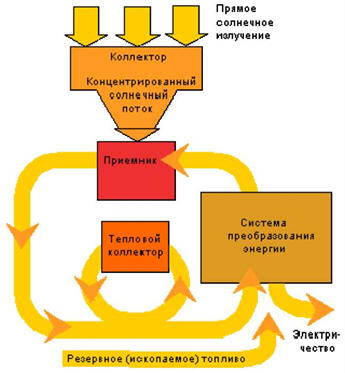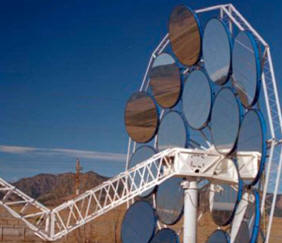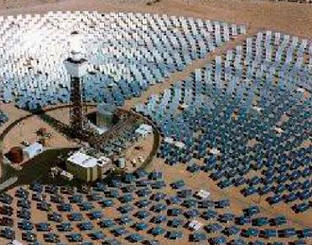
|
|
ENCYCLOPEDIA OF RADIO ELECTRONICS AND ELECTRICAL ENGINEERING Solar thermal power plants. solar concentrators. Encyclopedia of radio electronics and electrical engineering
Encyclopedia of radio electronics and electrical engineering / Alternative energy sources Such power plants concentrate solar energy using lenses and reflectors. Since this heat can be stored, such stations can generate electricity as needed, day or night, in any weather. Large mirrors - with a point or linear focus - concentrate the sun's rays to such an extent that the water turns into steam, while releasing enough energy to turn the turbine. Luz Corp. installed huge fields of such mirrors in the Californian desert. They produce 354 MW of electricity. These systems can convert solar energy into electricity with an efficiency of about 15%. All the described technologies, except for solar ponds, use concentrators to achieve high temperatures, which reflect the light of the Sun from a larger surface to a smaller receiver surface. Typically, such a system consists of a concentrator, a receiver, a coolant, a storage system, and an energy transmission system.
Solar heat can be stored in many ways. Modern technologies include parabolic concentrators, solar parabolic mirrors and solar power towers. They can be combined with fossil fuel combustion plants and in some cases adapted for heat storage. The main advantage of such hybridization and thermal storage is that such a technology can provide scheduling of electricity production (that is, electricity generation can be performed at times when it is needed). Hybridization and heat storage can increase the economic value of electricity produced and reduce its average cost. Parabolic (tray) system These installations use parabolic mirrors (trays) that concentrate sunlight on receiving tubes containing a heat transfer fluid. This liquid is heated to almost 400°C and pumped through a series of heat exchangers; this produces superheated steam, which drives a conventional turbine generator to produce electricity. To reduce heat loss, the receiving tube may be surrounded by a transparent glass tube placed along the focal line of the cylinder. As a rule, such installations include uniaxial or biaxial solar tracking systems. In rare cases, they are stationary.
Estimates of the technology show that it is more expensive than tower and dish type solar power plants, mainly due to lower concentration of solar radiation, and therefore lower temperatures and, accordingly, efficiency. However, with more operating experience, improved technology and reduced operating costs, parabolic concentrators may be the least expensive and most reliable technology of the near future. Built in the 80s in the Southern California desert by Luz International, nine of these systems make up the world's largest solar thermal power plant today. These power plants supply electricity to the Southern California public electricity grid. Back in 1984, Luz International installed a 13,8 MW Solar Electric Generating System I (or SEGS I) in Deggett, Southern California. In the receiving tubes, the oil was heated to a temperature of 343°C and steam was generated to generate electricity. The "SEGS I" design provided for 6 hours of heat storage. It used natural gas ovens, which were used in the absence of solar radiation. The same company built similar power plants "SEGS II - VII" with a capacity of 30 MW. In 1990, "SEGS VIII and IX" were built at Harper Lake, each with a capacity of 80 MW. Due to numerous legislative and political difficulties, Luz International and its affiliates filed for bankruptcy on November 25, 1991. Now stations "SEGS I - IX" are operated by other firms under the old contract with "Southern California Edison". The plans to build "SEGS X, XI, XII" had to be abandoned, which meant the loss of an additional 240 MW of planned capacity.
Solar plate type This type of solar plant is a stack of parabolic dish mirrors (similar in shape to a satellite dish) that focus solar energy onto receivers located at the focal point of each dish. The liquid in the receiver is heated up to 1000°C and is directly used to generate electricity in a small engine and generator connected to the receiver.
In addition, thanks to modular design, such systems represent the best option to meet the power needs of both stand-alone consumers (in the kilowatt range) and hybrid (in the megawatt range), connected to the utility grids. This technology has been successfully implemented in a number of projects. One of them is the STEP (Solar Total Energy Project) project in the US state of Georgia. This is a large system of parabolic mirrors that worked in 1982-1989. in the Shenandoah. It consisted of 114 mirrors, each 7 meters in diameter. The system produced high pressure steam for power generation, medium pressure steam for the knitting industry, and low pressure steam for the air conditioning system in the same knitting factory. In October 1989, the power company closed the station due to damage to the main turbine and lack of funds to repair the station. Stirling and Brayton engines are currently under development. Several pilot systems ranging from 7 kW to 25 kW are in operation in the United States. High optical efficiency and low initial cost make mirror/motor systems the most efficient of all solar technologies. The Stirling engine and parabolic mirror system holds the world record for the most efficient conversion of solar energy into electricity. In 1984, the Rancho Mirage in California achieved a practical efficiency of 29%.
A joint venture between Sandia National Lab and Cummins Power Generation is currently trying to commercialize a 7,5kW system. Cummins hopes to sell 10 units a year by 000. Other companies are also interested in using parabolic mirrors and Stirling engines together. For example, Stirling Technology, Stirling Thermal Motors, and Detroit Diesel, together with Science Applications International Corporation, formed a $2004 million joint venture to develop a 36-kilowatt system based on the Stirling engine. Solar power towers with a central receiver These systems use a rotating field of heliostat reflectors. They focus sunlight onto a central receiver built on top of the tower, which absorbs heat energy and drives a turbine generator. A computer-controlled biaxial tracking system positions the heliostats so that the reflected sun rays are stationary and always fall on the receiver. The liquid circulating in the receiver transfers heat to the heat accumulator in the form of steam. The steam drives a turbine to generate electricity or is directly used in industrial processes. Temperatures at the receiver reach from 538 to 1482 °C.
The first tower plant, called "Solar One" near Barstow, Southern California, successfully demonstrated the application of this technology to power generation. The company operated in the mid-1980s. It used a water-steam system with a capacity of 10 MWe. In 1992, a consortium of US energy companies decided to upgrade Solar One to demonstrate a molten salt receiver and thermal storage system. Thanks to heat storage, tower power plants have become a unique solar technology that allows electricity dispatching at a load factor of up to 65%. In such a system, molten salt is pumped from a "cold" tank at a temperature of 288°C and passes through a receiver, where it is heated to 565°C, and then returned to the "hot" tank. Now hot salt can be used to generate electricity as needed. In modern models of such installations, heat is stored for 3 to 13 hours.
Solar Two, a 10 MW power tower in California, is the prototype of large industrial power plants. It provided electricity for the first time in April 1996, marking the start of a 3-year period of testing, evaluation and pilot power generation to demonstrate the molten salt technology. Solar heat is stored in molten salt at a temperature of 550°C, thanks to which the station can generate electricity day and night, in any weather. The successful completion of the "Solar Two" project should facilitate the construction of such towers on an industrial basis in the capacity range from 30 to 200 MW. Comparison of specifications The table summarizes the key characteristics of the three options for solar thermal power generation. Towers and parabolic-cylindrical concentrators work optimally as part of large, grid-connected power plants with a capacity of 30-200 MW, while disk-type systems consist of modules and can be used both in stand-alone installations and in groups with a total capacity of several megawatts. Parabolic troughs are by far the most advanced solar energy technology and are likely to be used in the near future. Tower-type power plants, due to their efficient heat storage capacity, can also become solar power plants in the near future. The modular nature of the "trays" allows them to be used in smaller installations. Towers and "dishes" make it possible to achieve higher efficiency values for converting solar energy into electrical energy at a lower cost than parabolic concentrators. However, it remains unclear whether these technologies will be able to achieve the required reduction in capital costs. Parabolic concentrators are now a proven technology, waiting for their chance to improve. Tower power plants need to demonstrate the efficiency and operational reliability of molten salt technology using inexpensive heliostats. For poppet-type systems, it is necessary to create at least one commercial engine and develop an inexpensive concentrator. Characteristics of solar thermal power plants
(p) = forecast; (d) = fact Comparison of major solar thermal technologies
Some economic and design problems of thermal solar power plants The cost of electricity produced by thermal solar power plants depends on many factors. Among them are capital costs, operating costs and maintenance costs, system performance. However, it is important to note that the cost of the technology and the final cost of the generated electricity are subject to a significant influence of external factors that are not directly related to this technology. For example, parabolic concentrators and small stand-alone towers can be quite expensive. In order to reduce their cost and make them competitive with modern fossil fuel power plants, it is necessary to gradually increase their capacity and build solar energy centers, where several energy facilities are located on the same site. In addition, as these technologies replace traditional fuels, tax regulation can have a significant impact on their competitiveness. Cost versus value Through heat storage and hybridization, thermal solar power plants can become a sustainable and flexible source of electricity. It is reliable and able to produce electricity when it is needed. As a result, controlled electricity is of high value to the utility as it offsets the need to build and operate new power plants. This means that while a solar thermal power plant may cost more than a traditional one, the value can be higher. Advantages of solar power plants Thermal solar power plants create two and a half times more skilled, high-paying jobs than traditional power plants that burn fossil fuels. The California State Energy Commission conducted a study that showed that even with existing tax credits, a solar thermal power plant has to pay approximately 1,7 times more federal and local taxes than an equivalent capacity combined cycle plant. If the same taxes were paid for these power plants, the cost of electricity produced by them would be approximately the same. Potential If only 1% of the earth's deserts were used for the production of clean solar thermal electricity, it would be received more than is generated today by burning fossil fuels around the world. Conclusions Technologies for generating solar thermal electricity based on the concentration of sunlight are at different stages of development. Parabolic concentrators are already used on an industrial scale today: in the Mojave Desert (California), the installation capacity is 354 MW. Solar power towers are in the phase of demonstration projects. A pilot project called "Solar Two" with a capacity of 10 MW is being tested in Barstow (USA). Disk-type systems are going through the stage of demonstration projects. Several projects are in design development. A 25-kilowatt prototype station is operating in Golden (USA). Solar thermal power plants have a number of features that make them a very attractive technology in the expanding global renewable energy market. In Ukraine, under Soviet rule, in the 80s, an experimental solar power plant with a capacity of 5 MW was built near the city of Shchelkino, Leninsky district of the Autonomous Republic of Crimea. At the time of perestroika, when financial support from the state disappeared from the solar power plant, the solar power plant could not recoup its own operating costs. The solar power plant was stopped and plundered. In 2005, the solar power plant was finally dismantled in accordance with the decision of the Ministry of Fuel and Energy of Ukraine. Thermal solar power plants have come a long way over the past few decades. Continued development work should make these systems more competitive with fossil fuels, increase their reliability and provide a serious alternative in the face of ever-increasing demand for electricity.
Alcohol content of warm beer
07.05.2024 Major risk factor for gambling addiction
07.05.2024 Traffic noise delays the growth of chicks
06.05.2024
▪ Frameless smartphone with built-in solar battery ▪ Successful control of hot qubits ▪ Fear of pain and brain activity
▪ section of the site Normative documentation on labor protection. Article selection ▪ article You have your own wedding, we have our own. Popular expression ▪ Article How many fingers does a two-toed sloth have? Detailed answer ▪ article Violation of labor protection rules ▪ article Cambodian proverbs and sayings. Large selection
Comments on the article: Sergei Mikhailovich Dovbush, rocosov@yandex.ru There is enough sun everywhere for everyone in the summer, and for the cold winter months, reserves of huge heat accumulators are needed, equipped deep underground. For this, it is cost-effective to use exhausted coal pits. hot water supply.
Home page | Library | Articles | Website map | Site Reviews www.diagram.com.ua |






 Arabic
Arabic Bengali
Bengali Chinese
Chinese English
English French
French German
German Hebrew
Hebrew Hindi
Hindi Italian
Italian Japanese
Japanese Korean
Korean Malay
Malay Polish
Polish Portuguese
Portuguese Spanish
Spanish Turkish
Turkish Ukrainian
Ukrainian Vietnamese
Vietnamese







 Leave your comment on this article:
Leave your comment on this article: